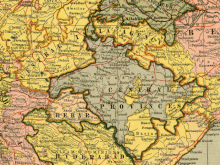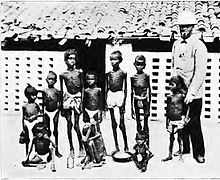Central Provinces
| Central Provinces | |||||||||||
|---|---|---|---|---|---|---|---|---|---|---|---|
British India | |||||||||||
| 1861–1903 | |||||||||||
 Central Provinces and Berar in 1903, before the 1905 changes to the eastern boundary | |||||||||||
| Capital | Nagpur (primary capital) Pachmarhi, Hoshangabad district (summer capital) | ||||||||||
| History | |||||||||||
• Merger of the Saugor and Nerbudda Territories and Nagpur Province | 1861 | ||||||||||
• Nimar added to Central Provinces | 1864 | ||||||||||
• Creation of the Central Provinces and Berar | 1903 | ||||||||||
| |||||||||||
| This article incorporates text from a publication now in the public domain: Chisholm, Hugh, ed. (1911). "Central Provinces and Berar". Encyclopædia Britannica. Vol. 5 (11th ed.). Cambridge University Press. pp. 681–3. | |||||||||||

The Central Provinces was a
The Central Provinces was formed in 1861 by the merger of the
Geography
The Central Provinces was
The northernmost portion of the state extended onto the
The Satpura Range divides the Narmada valley from the Deccan Plateau to the south. The Central Provinces included the northeastern portion of the Deccan, drained by tributaries of the Godavari River including the Wainganga, Wardha, and Indravati. These flow east towards the Bay of Bengal. A portion of Berar lay in the upper basin of the Tapti River, which drains westward into the Arabian Sea. The portion of the Central Provinces on the Deccan Plateau formed the Vidarbha region, which includes Nagpur, the capital of the province.
The eastern portion of the state lay in the upper
Demographics
| Year | Pop. | ±% p.a. |
|---|---|---|
| 1866 | 9,000,000 | — |
| 1872 | 9,250,000 | +0.46% |
| 1881 | 11,500,000 | +2.45% |
| 1891 | 13,000,000 | +1.23% |
| 1901 | 11,873,029 | −0.90% |
General censuses were held in 1866, 1872, 1881, 1891 and 1901. The population in 1866 was over 9 million, and in 1872 over 9.25 million. 1869 was a famine year. There were epidemics of smallpox and cholera in 1872, 1878, and 1879. By 1881 the population had risen to 11.5 million, and by 1891 to nearly 13 million. The population in 1901 was 11,873,029, a reduction of 800,000 from 1891. The lack of summer monsoon rains in 1897 and 1900 led to widespread crop failures and huge famines in those years, and there were partial crop failures in four other years in the decade, with epidemics of cholera in seven of the ten years. A portion of the decrease (between one-eighth and one-quarter) was from emigration to Assam and other provinces of India.[3]
Linguistic regions
The central Provinces contained two distinct linguistic regions:
In the 1901 census, 6,111,000 (63% percent) of the population spoke variants of Hindi, chiefly
Politics and administration
The Central Provinces were administered from 1861 to 1920 by a chief commissioner.
Administratively, the Central Provinces consisted of four divisions (
See also
References
- ISBN 81-85119-58-9.
- ^ Philip F. McEldowney (1980). Colonial Administration and Social Developments in middle India: The Central Provinces, 1861-1921 - Ph. D. Dissertation. University of Virginia.
- ^ Imperial Gazetteer of India, (New ed.), Oxford: Clarendon Press, 1908-1909. Vol. 10, Page 19.
- ^ Raghaw Raman Pateriya, Provincial Legislatures and the National Movement. Northern Book Centre, 1992. pg. 9
- ^ Imperial Gazetteer of India, (New ed.), Oxford: Clarendon Press, 1908-1909. Vol. 10, pp. 24-25.
- ^ Imperial Gazetteer of India, (New ed.), Oxford: Clarendon Press, 1908-1909. Vol. 10, Page 65.
- Markovits, Claude (ed.) (2004). A History of Modern India: 1480-1950. Anthem Press, London.


